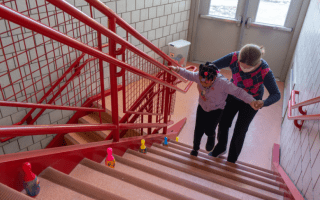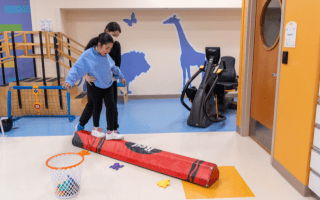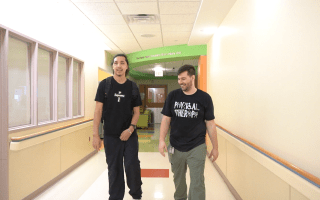Jonathan's Journey
A complex diagnosis improved through the efforts of an interdisciplinary team.
Blanca knows her son Jonathan is a strong fighter. Just three months into her pregnancy, Jonathan was diagnosed with aortic valve canal and trivial left and trivial right aortic valve regurgitation, pulmonary hypertension, intrauterine growth restriction, short limbs, hydronephrosis, and Trisomy 21 or Down syndrome. Born at 37-weeks gestation, Jonathan was immediately admitted to the NICU at Cohen Children's Medical Center and placed on non-invasive breathing support including a high-flow nasal cannula.

Jonathan required surgery to repair the valve in his heart, however, he continued to have persistent issues with his breathing.
"He specifically had high blood pressure in his lungs," said Stephen Leinenweber, MD, FAAP, Chief Medical Officer at Blythedale Children's Hospital. "And it was making it hard for his heart and hard for his lungs to work properly."
Jonathan's complexity required an interdisciplinary approach to his care. His ongoing issues with his heart and lungs made it difficult for him to breathe, swallow, and eat and therefore, he was unable to grow.
"What we know about many of these problems is that they get better over time," said Leinenweber. "So growth is actually one of the most important things we do."
In October, Jonathan was admitted to Blythedale for complex post-surgical rehabilitation and post acute neonatal care. Under heavy sedation to allow his body to rest and recover, Jonathan wasn't initially interested in playing. However, that changed quickly.
"One month after he came to Blythedale," said Blanca. "I saw that he started to play and move. I saw progress in Jonathan."

Each morning members of Jonathan's clinical care team assessed his progress. This included Dr. Dennis Davidson, a neonatologist and Chief of Blythedale's Infant and Toddler Unit, nurse practitioners, highly skilled respiratory therapists and pediatric nurses who monitored his breathing and vitals, and pharmacists for medication management. Additionally, his speech therapist worked to ensure he was swallowing safely, and working with his nutritionist to maintain his caloric intake. Jonathan was also born with low tone in his body and his occupational and physical therapists provided him with daily therapy sessions to assist him with his movement and ability to sit up.
Jonathan's tachypnea or rapid breathing concerned his team and they transitioned Jonathan to a nasogastric tube to provide him with adequate nutrition without fear of aspiration. Through Blythedale's Parent and Family Education team, Blanca was trained on how to care for his NG tube and assist Jonathan with feedings.
"Jonathan's mom wants what all moms want: to bring her baby home," said Arleen Ott, MSN, RN, CPN, Nursing Director of the Infant and Toddler Unit. "We were able to give Mom the steps and skills needed to bring him home."
Jonathan improved significantly during his stay at Blythedale. He was successfully weaned from ventilator support and his chronic bronchopulmonary dysplasia resolved. The day before he left, his speech therapist, Rachel Ferrara trialed sweet potatoes with him for the first time, helping Jonathan transition to eating by mouth.
Jonathan and his family headed home in April with his big sister ringing his discharge bell throughout Blythedale's hallways as staff wished them good luck in the future.



